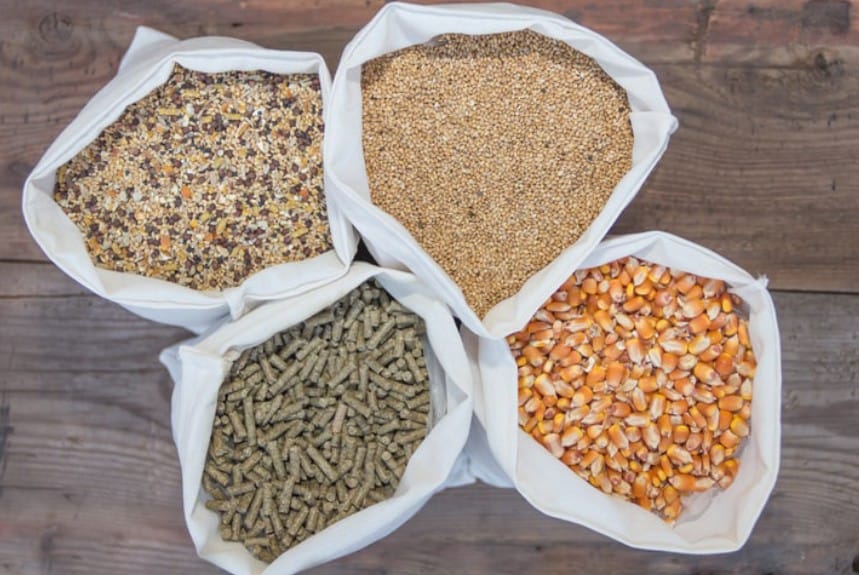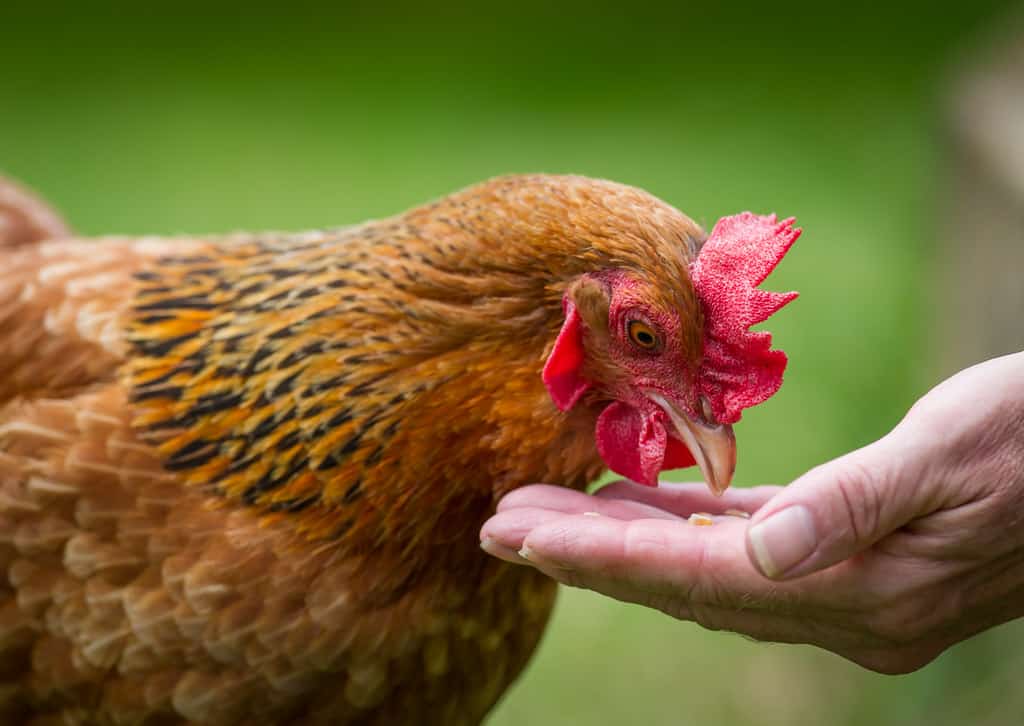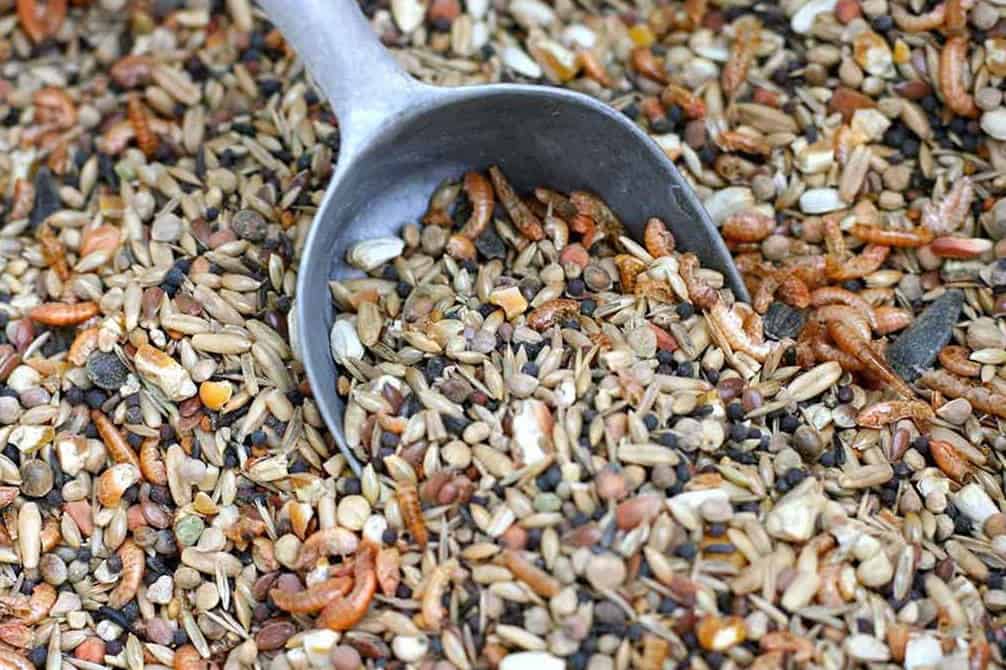Raising chickens can be enjoyable, particularly if you reward them occasionally. A great way to do that is by feeding chicken scratch, which is something most hen breeds love. What is chicken scratch, and how should it be used? Here is more information.

What is Chicken Scratch?
Chicken scratch is a type of feed that consists of different kinds of seeds and grains that hens enjoy eating. For example, it may contain cracked corn, barley, wheat, oats, or sunflower seeds. Considered a treat, birds will “scratch” around in the dirt to pick up every last bit, hence the name.
Scratch may have originated from early farmers, who would throw out their leftover grains and seeds for chickens to rummage through. The hens loved the food, and farmers were able to avoid unnecessary waste by giving it to them. By providing scratch, early farmers could also stretch their regular chicken feed.
Chicken Scratch vs. Chicken Feed: The Difference

Although chicken scratch and chicken feed are both types of food, there are still a few differences between them. The biggest one involves nutritional value. Commercial chicken feeds are fortified with minerals and nutrients such as selenium and calcium carbonate. Accordingly, it ensures healthy birds and high-quality eggs.
Scratch, on the other hand, is like junk food for chickens. That’s because it lacks the nutrients found in commercial chicken feed. As such, it is not recommended as a diet staple. Instead, you may give it to your hens only occasionally to supplement their diet or as a treat.
Since it contains higher-quality ingredients, regular chicken feed costs more. Even so, your extra money will pay off in the long run with a higher egg yield. Additionally, hens that are well-fed yield more meat of better nutritional value when slaughtered.
Some other significant differences between chicken scratch and chicken feed include:
- Protein content: High-quality chicken feed will contain between 15 and 18 percent protein, while chicken scratch typically has less than ten percent protein.
- Calcium content: Chicken feed should have a calcium content of around three percent. Chicken scratch, on the other hand, typically contains little, if any, calcium. Low calcium content can result in very thin eggshells.
- Chicken feed does not encourage scratching activity: Accordingly, your hens may not be motivated to forage for bugs, overturn their litter, and maintain sanitary conditions.
- You can often purchase chicken scratches at department or pet supply stores. Chicken feed, on the other hand, usually is available only through farm-and-fleet stores.
Guidelines for Feeding Scratch Grains

Now that you know the difference between chicken scratch and regular feed, you can now learn how to use it. When given properly, the chicken scratch can be an economical solution to enjoy giving to your hens. Here are some basics to consider.
How Much to Feed
Despite its lower nutritional value, chicken scratch can still be given to your chickens. However, you should ensure that your hens’ diet is not primarily made up from scratch. Consequently, one guideline to follow involves seeing that no more than 10% of your chickens’ diet consists of scratch grains.
One sign that you are feeding too much scratch involves many leftovers. When chickens are full, they will leave scratches on the ground, where they can become wet and moldy. Leftover scratches can also attract insects and vermin. Anytime there is a leftover scratch, you should clean it up immediately. Take note of the amount you are throwing away so that you can adjust your feeding the next time.
A good rule of thumb involves feeding your birds only as much as they can consume within 20 minutes. After that time, you should clean up the remaining scratch.
How Often to Feed Scratch

So long as you do not exceed the recommended limits, there is no set interval for feeding chicken scratch. Some farmers give it daily, while others do so only occasionally. It depends on your feeding habits and the availability of chicken feed or scratch.
Those who feed scratch daily often mix it with their regular chicken feed. This is a great way to ensure you do not overfeed your hens. However, if you do choose this method, you should not give additional scratches as a treat because that would then result in overfeeding.
When Should You Feed Scratch?
When they first get them, many will give their hens a scratch because doing so helps them build trust. In that way, they can teach birds to eat from their hand. This may make gathering eggs easier to do in the future. However, if you have raised poultry for some time but have never given a scratch, it is never too late to start.
Those who show or train chickens may give scratches when teaching them new tricks. This is akin to a dog trainer using biscuits to achieve positive results. Many trainers claim that chicken scratch has helped their hens become comfortable enough to be handled sufficiently to become pets.
One benefit of giving scratch is that it encourages natural scratching behavior. Accordingly, if your hens have recently been inactive due to illness or inclement weather, providing scratch can help them to get their activity levels up again.
As with humans, chickens require additional food during the winter. Therefore, you may want to give a chicken scratch during a cold spell. Doing so will spur their digestive system to produce heat and help keep the birds warm. While scratch can help chickens stay warm, you should never feed more than 10% of their diet in the way of scratch. If your hens still need additional nourishment, provide it in the form of regular chicken feed.
You may wish to provide a scratch just before bedtime. This will help your hens feel full at night so they can better get a good night’s sleep.
The Dangers of Giving Chicken Scratch to Poultry

Providing chickens with scratch feed can have both positive and negative effects on the fowl as well as their caretakers. The blend usually comprises corn, wheat, barley, and some mineral supplements that contribute toward general dietary nourishment. However, it also poses risks when given above the recommended serving size. Some harmful effects are:
- Obesity
- Malnutrition
- Pest Infestation
Feeding your chickens scratch feed can have both positive and negative effects. Chicken scratch is a blend of corn, wheat, barley, and minerals that provides important nourishment for your feathered friends. However, it’s also risky if given in too large amounts.
If you overfeed them with chicken scratch they may suffer from malnutrition due to lack of necessary nutrients or weight gain issues such as obesity without enough exercise – this will impact their egg-laying abilities.
Improper storage habits are what can lead to pest infestation, especially rats, during certain seasons. They leave droppings that spread diseases among the flock leading to contamination and resulting in viral spreading among the inhabitants of your farm.
Used in moderation, chicken scratch is unlikely to affect your hens’ health or laying capabilities. So if you notice a decline in health or decreased egg production, this may indicate you are giving too much scratch. Reduce the amount you are offering, or eliminate it entirely. If you do not notice any improvement, consult with a veterinarian.
Homemade Chicken Scratch Grain Recipe

As with chicken feed, you may purchase scratch in bulk. Even so, you may wish to make your own chicken scratch at home. Making your own chicken scratch is often more economical and will give you a sense of accomplishment.
It also allows you to better control the ingredients to avoid artificial ingredients, GMOs, or unnecessary additives. Here is a basic recipe you can use to create your own batch of chicken scratch:
Add the following ingredients to an oversized mixing bowl or garden tub:
- 1 part cracked corn
- 1 part barley
- 1 part wheat
- 1 part oats
- 1 part sunflower seeds
- 1 part peas
Mix the above ingredients by hand until they are evenly distributed. Store in an airtight container until ready to use. Keep this container in a dry location with adequate ventilation, and check regularly for signs of spoiling.
Using all of the above ingredients in your homemade chicken scratch is unnecessary. So if you have only a few of the items, you can still make a delicious scratch meal that your hens are bound to enjoy.
You can also experiment with different variations to create a custom recipe. If you are on a budget, you may even want to limit the number of sunflower seeds you use since this can significantly add to the cost of making a scratch.
Variations
For added variety, you may add a few handfuls of the following:
When making homemade chicken scratch, you may purchase a bag of a commercial product containing grains such as cracked corn, oats, or wheat and then add other ingredients around the house. This is an excellent alternative if you only have a few hens and do not want to buy several bags of grains.
You may also mix and match the ingredients based on your hens’ preferences. Some people will even add a few table scraps such as rice, broccoli, or watermelon rinds. When feeding table scraps, avoid the following items that would potentially be toxic:
- Greasy foods such as fried or fatty items, gravy, etc.
- Meats
- Eggs or egg-based dishes
- Milk or dairy products
- Potatoes and potato peels(russet potatoes only; sweet potatoes are actually not harmful to chickens)
- Moldy bread(you should also use bread only in minimal amounts)
Summary
Chicken scratch has been a staple for poultry growers over the years. Modern feeding methods haven’t changed the need or desire for chicken scratch. Use wisely, and you will notice some very positive benefits from supplementing your hens’ diet with scratch.

Joseph Hudson has been raising chickens for over 15 years. In 2018, he completed the Agriculture & Natural Resources program at Mt. San Antonio College. He currently raises over 1400 chickens on his 7.5-hectare farm. He keeps sharing his experience on raising healthy and happy chickens on Chicken Scratch The Foundry.







New to caring for chickens
I have three hens, one nesting
Very helpful article
With only three, I want to make my scratch
I’ve heard good things about DE, but some info warned about accidently breathing it in, that it could hurt the lungs. If it could hurt people’s lung, could it hurt animal’s lungs? Have you heard this?
Humans wear masks and protective gear when working around diatomaceous earth. If humans have to wear it then it would make sense that it would be dangerous for chickens as a loose form. DE is a fine ground glass. In a damp form as food it is less dangerous. Choose for yourself. I do not use powdered form anywhere near my chickens.
Diatomaceous Earth is fossilized remains of diatoms not glass. In pure form it is safe for humans to digest. I use it in my chickens feed and dusting area. I also use it on my dog. It is a great treatment for parasites, fleas and ticks. I also use it in my garden as a treatment for slugs and plant eating caterpillars on my brassica and onions. Do not use the DE that is meant to be used on plants for your animals. It is mixed with other ingredients. I buy the pure one meant to be used for humans and multipurpose it.
You are right. Diatomaceous Earth does come from diatoms. Food-grade DE is safe and beneficial. Most people don’t realize that all grains that are stored for human consumption have been stored with DE sprinkled in to prevent insect damage. We’ve been eating it for years.
Food grade is definitely different from the kind used in swimming pool filters. That is the one that is not good for you to breathe. But then again, too much of ANY dust is not good to breathe.
For my hens to take their dust baths, I use a small blue kiddy pool filled with clean dirt, DE, poultry dust (pyrethrin). I keep it inside their pen and it is especially useful to them in the winter months when they can’t find dry areas to dust bathe outside.
I also meant to say that I mix a bit of DE into my homemade scratch, too. Besides keeping bugs out of my scratch, it is good for internal cleansing for the hens.
There is a pool grade DE which you wouldn’t want to use around pets nor yourself but the food grade DE is what you want.
Great information. I’m getting 4 chickens soon and I want to take good care of them . Thank you
I also meant to say that I mix a bit of DE into my homemade scratch, too. Besides keeping bugs out of my scratch, it is good for internal cleansing for the hens.
Chickens eat bugs so why would you want to make it where bugs aren’t attracted to where they are eating? Especially if the scratch doesn’t have the nutrition… Also why avoid giving them meat when they are meat eaters naturally?
I wondered the same thing….
D.E. isnt a perfect weapon against all insects, however its extremely effective against fleas, ticks, etc.
Insects in a coops not horrible, but D.E. helps keep things in check. Some coops have nooks where the birds cannot reach. With DE, there is less risk of those areas becoming safe havens causing perpetual infestation.